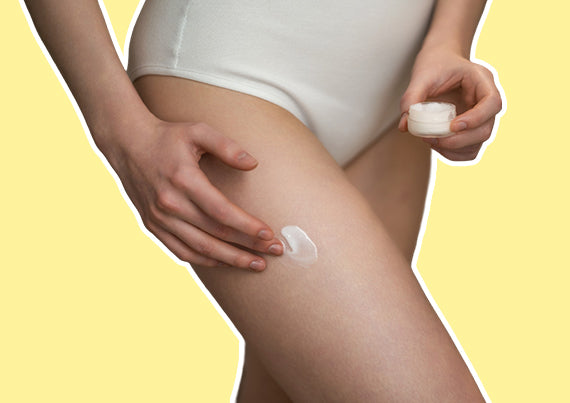Understanding the Causes and Triggers of Butt Acne

"Butt acne, while often overlooked, can be a frustrating and uncomfortable condition. Unlike facial acne, which tends to receive more attention, butt acne can linger in the shadows, causing embarrassment and discomfort for those affected. However, understanding the underlying causes and triggers of butt acne is crucial for effective management and relief."
Butt acne, also known as folliculitis, is a skin condition where pimples break out on the skin's surface due to friction, sweating, hormonal fluctuations, and poor hygiene. It is critical to understand the causes and triggers of butt acne to identify effective treatments and prevent aggravating the issue with the use of improper skin care products or harmful habits. This blog post will cover the intricacies of butt acne, including its scientific reasons, common causes, and specific triggers. Stress, sebaceous glands, lifestyle choices, and hair follicles will all be emphasized. By the end of the article, readers will have a comprehensive grasp of butt acne and practical tips for managing and preventing flare-ups.
What is Butt Acne?
Butt acne, also known as buttne or folliculitis, is a condition characterized by acne-like bumps or pimples on the buttocks. It is often misunderstood as a result of poor hygiene, but it is primarily caused by factors such as follicular occlusion, bacterial infection, and hormonal imbalances. It can manifest in various forms, including inflammatory and non-inflammatory lesions. Inflammatory lesions, such as papules, pustules, and cysts, are redness, swelling, and tenderness, often indicating an immune response to bacterial colonization within hair follicles. Non-inflammatory lesions, like blackheads and whiteheads, result from the accumulation of sebum and dead skin cells without significant inflammation. Butt acne is more common than one might think, affecting individuals of all ages, genders, and skin types. It is particularly prevalent during adolescence and early adulthood due to hormonal fluctuations and increased sebum production. However, it can persist into adulthood or develop later in life, especially in individuals who engage in activities that promote follicular occlusion. Certain medical conditions, medications, and hormonal imbalances can also predispose individuals to butt acne. Understanding butt acne, its various manifestations, and demographic groups can help individuals better recognize and address this stigmatized skin condition.
The Science Behind Butt Acne
Butt acne is a condition characterized by the blockage or obstruction of hair follicles due to factors such as excess sebum production, dead skin cell accumulation, and external factors like friction or pressure. Hair follicles, tiny structures in the skin that house the hair shaft, are connected to sebaceous glands, which produce an oily substance called sebum. This oily substance lubricates the skin and hair, maintaining moisture balance. However, when there is excess production or improper shedding of dead skin cells, the hair follicles can become clogged, leading to acne lesions.
Sebum serves several important functions in the skin, including moisturizing and protecting against pathogens. However, an overproduction of sebum, often influenced by hormonal changes, can contribute to acne development. Excess sebum mixes with dead skin cells and debris, creating a plug within the hair follicle, creating an ideal environment for bacteria to thrive, leading to inflammation and acne lesions. Factors such as tight clothing, prolonged sitting, and friction against the buttocks can also contribute to follicular occlusion. Understanding the interplay between hair follicles, sebaceous glands, and follicular occlusion can help individuals implement effective prevention and treatment strategies for butt acne.
Common Causes of Butt Acne
Butt acne is a common skin condition caused by various factors. Tight clothing and synthetic fabrics can exacerbate the issue by trapping sweat and heat against the skin, creating an environment conducive to bacterial growth and follicular occlusion. These fabrics, such as skinny jeans or leggings, also increase friction against the buttocks, leading to irritation and inflammation of hair follicles. To minimize the risk of butt acne, individuals should opt for loose-fitting, breathable clothing made from natural materials like cotton or linen, especially during physical activity or hot weather.
Inadequate hygiene practices, such as infrequent cleansing or improper exfoliation, can contribute to the buildup of sweat, bacteria, and dead skin cells on the buttocks, increasing the risk of butt acne. Exfoliation helps remove dead skin cells and unclog pores, promoting healthy skin turnover and preventing acne breakouts. However, it's essential to avoid over-exfoliating, as it can strip the skin of its natural oils and cause irritation.
Sweat and humidity create an ideal breeding ground for bacteria on the skin's surface, particularly in areas prone to friction and moisture, such as the buttocks. When sweat mixes with bacteria and dead skin cells, it can contribute to pore blockage and inflammation, leading to the development of butt acne. To minimize the impact of sweat and humidity on butt acne, individuals should practice good hygiene habits, such as showering after sweating and wearing breathable clothing that wicks moisture away from the skin. Topical products containing ingredients like salicylic acid or benzoyl peroxide can also help prevent acne formation by reducing bacterial proliferation and promoting exfoliation.
Identifying Personal Triggers
A skincare diary is a valuable tool for individuals seeking to identify personal triggers for butt acne flare-ups. By documenting daily activities, skincare routines, product usage, dietary choices, and lifestyle factors, individuals can gain insight into potential triggers and patterns associated with their butt acne. This helps them make informed decisions about their skincare regimen and lifestyle choices.
Identifying patterns in buttne flare-ups can be achieved through careful observation and analysis of their skincare diary. These triggers may include ingredients in skincare products, hormonal fluctuations, dietary habits, stress levels, or environmental factors like humidity and temperature. By identifying these triggers, individuals can take proactive steps to avoid or mitigate their impact, such as adjusting their skincare routine, modifying their diet, managing stress, or making lifestyle changes.
Important of individualized approaches to managing butt acne is the importance of understanding that what works for one person may not work for another. Each individual's skin is unique and influenced by factors such as genetics, lifestyle, and environmental exposures. Therefore, adopting a tailored approach to acne management is crucial for achieving optimal results. This may involve experimenting with different products, adjusting dietary habits, incorporating stress-reduction techniques, or seeking professional guidance from a dermatologist or skincare expert.
To enable readers to take an active role in recognizing and resolving their triggers for butt acne, we encourage individuals to keep a skincare diary, spot patterns, and focus on tailored methods for acne treatment. By developing self-awareness and making informed choices, individuals can create efficient acne management plans that lead to long-term confidence and healthy skin.
Lifestyle Factors and Butt Acne
Diet and nutrition play a significant role in determining the development of butt acne. Consuming foods high in refined sugars, saturated fats, and processed ingredients can increase inflammation and hormonal imbalance, leading to acne flare-ups. Nutrient-rich foods, such as fruits, vegetables, whole grains, and lean proteins, provide essential vitamins, minerals, and antioxidants that combat inflammation and promote hormonal balance.
Stress is a common trigger for butt acne flare-ups due to its impact on hormonal balance and immune function. Stress releases cortisol, a hormone that increases sebum production and inflammation in the skin, leading to acne lesions. Additionally, stress impairs the skin's natural barrier function, making it more susceptible to bacterial infections and external irritants. To minimize the impact of stress on butt acne, individuals can incorporate stress-reduction techniques into their daily routine, such as mindfulness meditation, deep breathing exercises, yoga, regular exercise, or spending time in nature.
Sleep and skincare routines are also crucial for overall skin health. Lack of sleep can disrupt repair and regeneration processes, leading to impaired skin barrier function, increased inflammation, and a higher likelihood of acne breakouts. Consistent skin care practices, such as cleansing, moisturizing, and exfoliating, are essential for preventing pore blockage and maintaining clear, healthy skin. Establishing a bedtime routine that includes proper skin care can help individuals manage butt acne and promote overall skin health.
Seeking Professional Guidance
Butt acne is a common condition that can be managed with over-the-counter treatments and lifestyle modifications. However, in some cases, professional guidance may be necessary, especially for individuals with severe or persistent acne lesions or those with underlying medical conditions, hormonal imbalances, or concerns about their skin health. A dermatologist can provide personalized treatment recommendations, perform diagnostic tests if needed, and help address any underlying issues contributing to butt acne.
Treatment options for butt acne may vary depending on the severity and underlying causes of the condition. Topical treatments like benzoyl peroxide, salicylic acid, or topical retinoids are commonly used to target acne lesions and reduce inflammation. Oral medications like oral contraceptives or antibiotics may be prescribed for more severe cases or those resistant to topical treatments. In some cases, procedural interventions like chemical peels, microdermabrasion, or laser therapy may be recommended to address scarring or persistent lesions. It's essential to consult with a dermatologist to determine the most appropriate treatment approach based on individual needs and skin type.
If you suffer from consistent butt acne try the Teenilicious Bum Body Cream, which is a gentle yet effective skincare solution designed to combat butt acne. It improves skin texture and promotes a harmonious skin tone. It is enriched with nourishing ingredients such as Shea Butter, Theobroma Cacao Seed Butter, Watermelon extract, and Retistar, providing deep hydration, gentle exfoliation, and sebum-regulating properties.
Butt acne is a common skin condition that can be caused by various factors such as clothing choices, poor hygiene practices, hormonal fluctuations, and lifestyle factors. Understanding the causes and triggers of butt acne is crucial for effective management and prevention. Lifestyle factors, such as diet, stress management, sleep hygiene, and skincare routines, also play a significant role in managing the condition. For severe or persistent cases, seeking professional guidance from a dermatologist or healthcare provider may be necessary. Treatment options for butt acne include topical treatments, oral medications, procedural interventions, and lifestyle modifications. By identifying the causes and triggers of butt acne, individuals can take control of their skin health and make informed decisions about their skincare routine, lifestyle choices, and treatment options. It is essential to seek support from healthcare professionals, such as dermatologists, who can provide personalized recommendations and guidance tailored to individual needs. Individuals can embrace their skin with confidence and vitality by learning about the origins and triggers of butt acne and exploring tailored treatment options.











